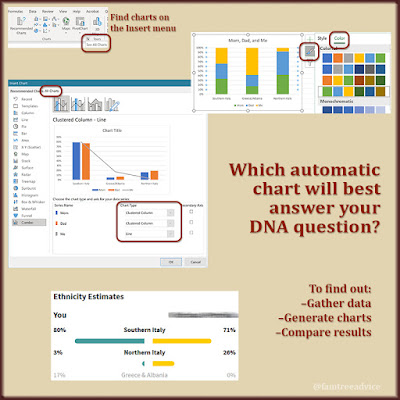My DNA matches are very out of balance. My paternal-side matches outnumber my maternal-side matches by more than 2 to 1. To make up for the big difference, I need to squeeze out the value of these matches to benefit my family tree.
My tree contains about 15,000 people (I kid you not) from my mother's father's hometown of Baselice. That's a result of a years-long project where I documented thousands of vital records in a text file. Then I worked the people into my family tree. Thanks to Italy's Antenati website, I have access to the rest of the town's records through 1942.
On Saturday I published a text file and an Excel file with names and links to more than 8,600 Baselice vital records. I've done the same for a few of my other ancestral towns, including Santa Paolina, Avellino.
Having done all this work, I'm as ready as I'll ever be to fit Mom's DNA matches into my family tree.
A Familiar Name
As I scroll down my list of maternal-side DNA matches, I see one with a last name I think I know. It looks like an Americanization of the name Ricciardelli. This name comes from Santa Paolina. That's the hometown of one of my 2nd great grandmothers.
My DNA match's 3-person tree turns out to be all I need. (I didn't see that coming.) The tree consists of her, her father, and her grandfather, Michele Ricciardelli. A quick search for her father shows me that his parents, Michele and Vincenza, are already in my family tree. Michele Ricciardelli is my 3rd cousin 3 times removed. When I add Michele's son and granddaughter to my tree, I see that my match is my 5th cousin once removed.
 |
| That was unexpected! My DNA match's 3-person family tree was all I needed to easily connected her to my extended family. |
I'll add a note to my DNA match list and choose another one to explore.
Another match has the name Ricciardelli in his family tree, too. He also has another name from the same town—Stanziale. I should be able to place this young man in my family tree.
As I view his tree, I see his 3rd great grandparents are in my family tree already. But their connection to me is not close at all. Each one has an in-law relationship to my 5th great uncle. I needed more facts.
I found my match's 2nd great grandparents' marriage documents and added the facts to my family tree. While I can't find a blood relationship with this DNA match, I can see a DNA connection. His 2nd great grandmother's sister married my 5th great uncle. The descendants of both sisters would share some DNA.
Since his tree has 2 generations of private, unnamed family, I won't add him to my family tree. But I made a detailed note on Ancestry DNA about how we may share DNA.
Another Familiar Name
I want to explore one more match whose grandmother Carmela was born in Santa Paolina. Carmela and her parents are not in my family tree. I'm sure I can find their connection by searching the documents.
The Santa Paolina documents, searchable on my computer, helped me place Carmela in my tree. But once again, there is no direct relationship. I'll go ahead and add as many facts as I can about this family. Maybe future research will show a closer relationship.
 |
| I've been building my own massive vital records database. Finding my DNA matches' relatives is a slam dunk. |
It looks as if my ancestors' neighbors and in-laws have descendants who have DNA-tested. And we share a small amount of DNA. Yes, I wish I had more and closer matches from my maternal side. But I can use my DNA matches to piece together extended families and see how far they've come.
Don't overlook the value of your 4th–6th cousin matches. They can extend your dead ends and open up new relationships.



